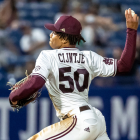So far this season, Major League Baseball teams are averaging 1.29 home runs per game. The widely held expectation is that more moonshots will be launched as the season progresses and temperatures rise across the land. Even if that rate remains static, baseball is on pace to set a new home-run record -- eclipsing the old mark (1.26) that was established way back in 2017.
As with that 2017 season, there are concerns about the integrity of the balls used. Rob Arthur, a writer at Baseball Prospectus who during the 2017 season found evidence of the ball's changed composition (MLB later confirmed Arthur's findings), concluded a week into the season that the ball had changed as compared to last year's model in a way that made home runs likelier. For a complete look at the MLB study on home run rates, click here.
| MLB season | HR rate* | K rate |
|---|---|---|
2019 (in progress) | 1.29 | 8.84 |
2018 | 1.15 | 8.48 |
2017 | 1.26 | 8.25 |
2016 | 1.16 | 8.03 |
2015 | 1.01 | 7.71 |
2014 | 0.86 | 7.70 |
Note: *Home run rate is view per team, per game
In ballplayer terms: the ball is juiced again. In nerd terms: the ball's aerodynamics are borked again.
To understand what any of that means, first you have to understand what goes into making a baseball. We don't mean touring the Rawlings factory in Costa Rica, but rather the literal ingredients, of which there are essentially three: the outer cowhide part everyone is familiar with, yarn and a core comprising cork and rubber.
The difference between a regular baseball and a juiced one tends to boil down to the density of the of the core. Arthur's research found that part of the core was 40 percent less dense in the 2017 balls than in the older balls. When paired with other changes, the result was a ball that had less "drag" -- or that was more likely to travel quicker and longer than its predecessor. That certainly seems to be validated by what we're seeing on the field each and every night thus far.
As does this observation put forth by longtime big-league reliever Eric O'Flaherty, who noted the tighter strike zone and livelier ball are contributing to teams' predilection for top-level velocity -- and, in turn, leading to more strikeouts and walks. Do note that the league is on pace to set another new record for strikeouts, something it's done each season since 2008.
Yes. Juiced balls and tight strike zone eliminate low velocity control pitchers from the contest. Control pitchers = more strikes, more balls in play and quicker at bats. Hard throwers = more foul balls, less balls in play, deeper counts, more K’s and BB’s. https://t.co/e8yHjQ6fQv
— Eric O’Flaherty (@EOF34) May 3, 2019
In a sense, much of what is believed to ail baseball could be exacerbated by ... well, the ball itself -- or, at least, the version of the ball being used right now.


















